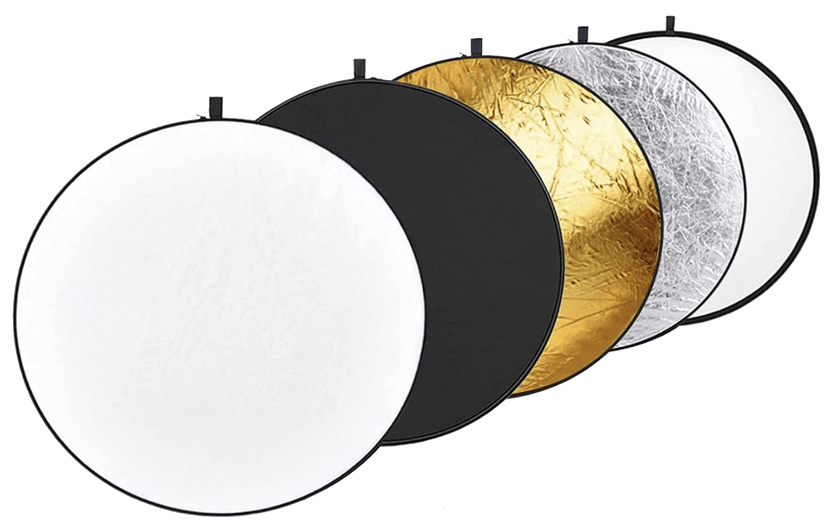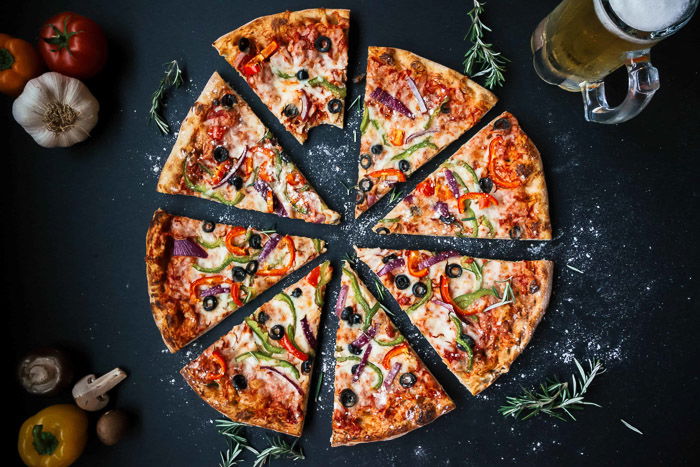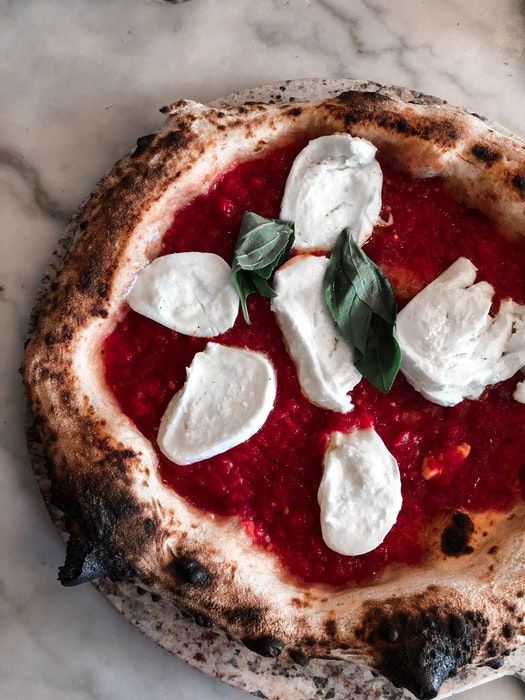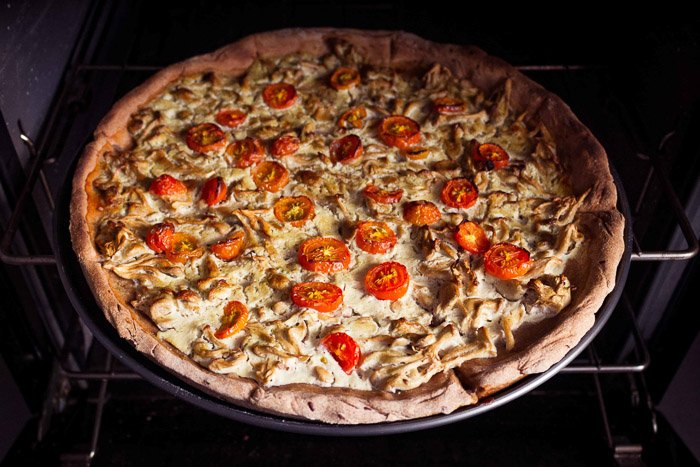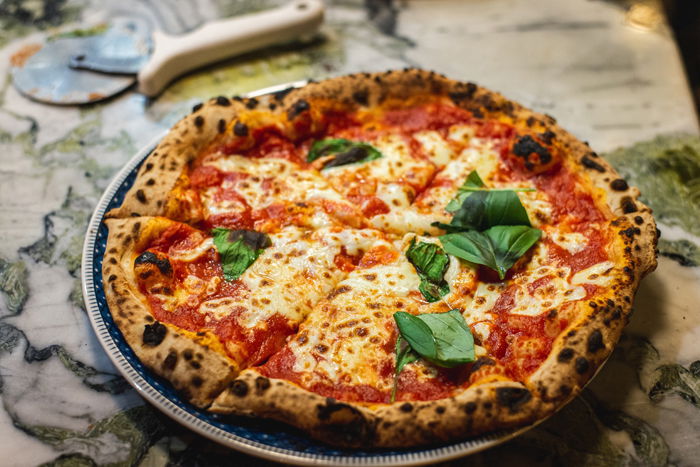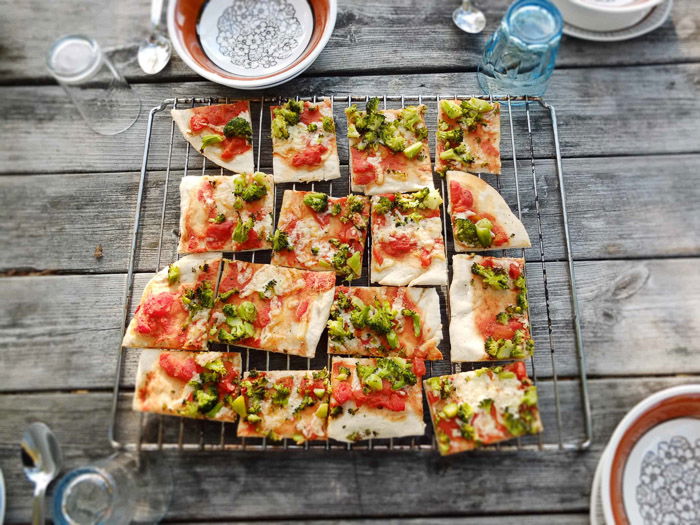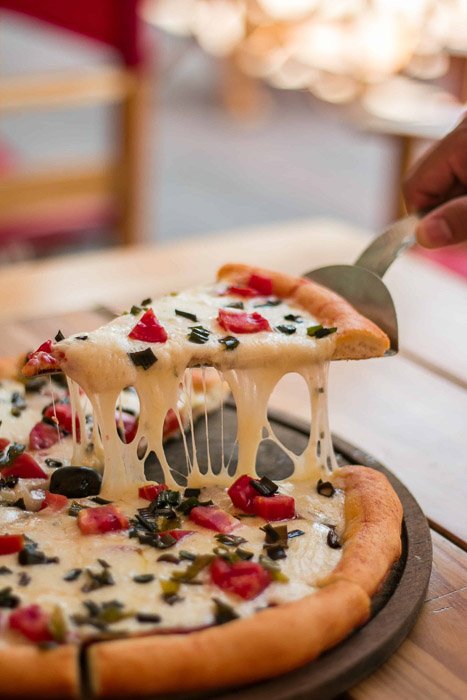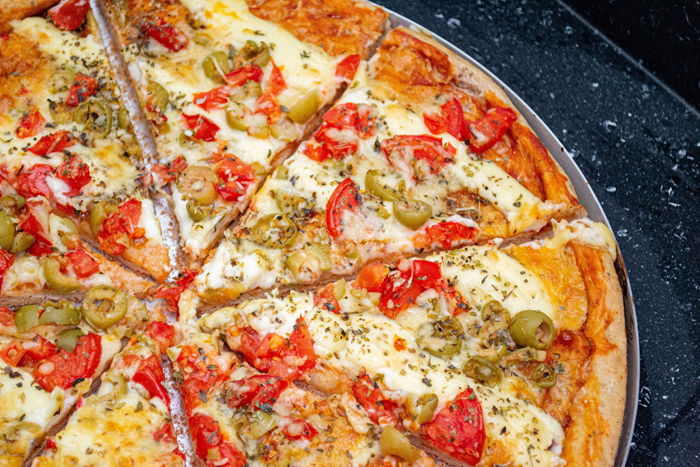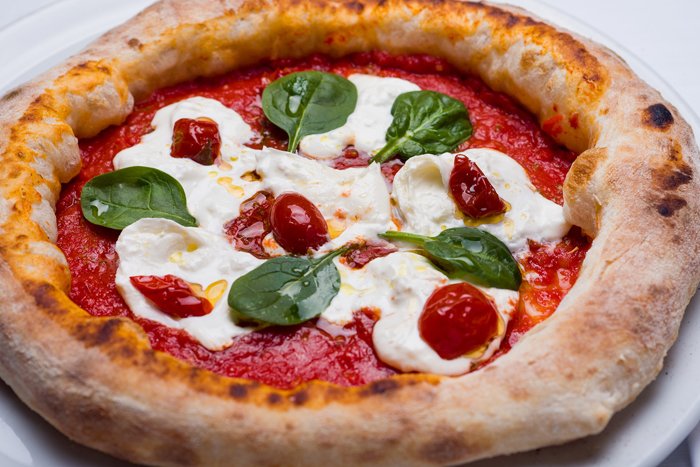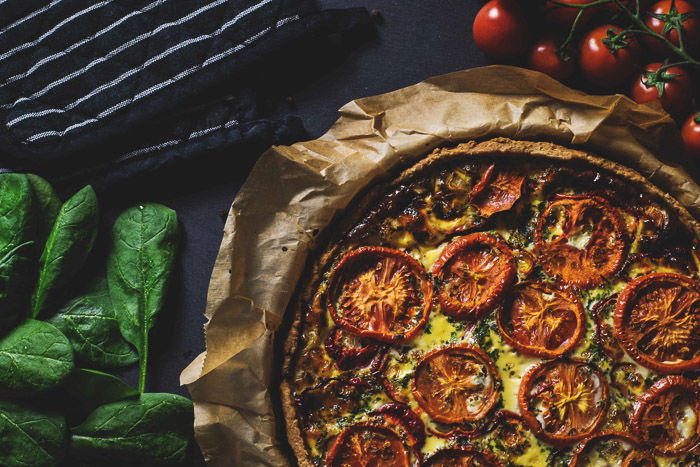Learning to photograph pizza is one of the most important skills in food photography. Here are seven tips to help you take stunning photos of the world’s beloved food. [ExpertPhotography is supported by readers. Product links on ExpertPhotography are referral links. If you use one of these and buy something, we make a little bit of money. Need more info? See how it all works here.]
7. Choose the Right Equipment for Perfect Pizza Photography Results
To shoot pizza, use a camera with a full frame sensor. This is ideal because of the higher resolution and depth-of-field. Your lens choice will depend on how you wish to frame the shot. If you want to shoot one or two pizzas from overhead, then a 50mm lens is a good choice. It will allow you to get more into the frame. Especially if you have a camera with a full frame sensor. Otherwise, a longer focal length would be suitable for most types of pizza photography, like an 85 mm or a 100mm. Don’t use a wide-angle lens, though. It will distort your pizza photography. Keep your wide-angle for tablescapes or larger food scenes.
6. Set up the Lighting for Well-Lit Images
The kind of lighting you choose for your pizza photography can vary. It will depend on your skills and the end-use of the photos. If you are shooting for your blog or stock photography, you have more freedom. You don’t need to be as exacting as you would for commercial pizza photos. You can use direct sunlight or natural lighting and get creative with your styling and camera angles. It’s essential to get your lighting right before you shoot. Editing can make a big difference in your food photography but it cannot make a poorly lit image look great. Make sure your light is directional. And watch the highlights. Melted cheese has a lot of shine and can look greasy.
A right approach is to light from the side. This reduces the highlights on the cheese. To further manage the highlights, bring them down in post-production. Use a fill card opposite your light source. This will ensure that your scene is evenly lit by bouncing the light back onto the subject. Backlighting can emphasise pizza’s texture. But it will also emphasise any grease. Side lighting is the safest option for pizza photography. If possible, use natural light because that makes your pizza pictures look the most realistic and delicious. Take the pizza pics nearby a window. Choose the time around sunrise or sunset to have the best light for your pizza photography. If the sunshine is too direct, use a white sheet or curtain to diffuse to light. This will also soften the harsh shadows.
5. Style the Pizza for Mouth-Watering Photos
Styling pizza is difficult. There are so many parts that need to come together in the right proportions to make it look tempting. Start with choosing the background. For pictures of pizza, I recommend simple and natural backdrops. A wooden table or checkered tablecloth are a good fit. Use relevant props. Some flour, a pizza cutter or basil leaves are simple yet describing. Pizza is a very simple dish, and your food photography should convey this simplicity. Remember, less is more! There are food stylists who specialise in pizzas because it can be such a fussy and critical job. You can buy or make your own pizza dough or pizza bases. Whichever you choose, partially cook the pizza base. Then top it with sauce and fillings. This way, the ingredients don’t have to stay in the oven long. If they do, they’ll wrinkle and dry out.
One of the things that you have to watch for is the amount of sauce you spread on the pizza base. You need much less sauce in photography than you would when preparing a pizza to eat. The sauce dilutes the look of the cheese. Brush a thin layer of sauce over the pizza base. Once the base is baked, add sauce along the edges of the pizza. Use a small brush or eyedropper. When food stylists work with tomato sauce, they often drain it on paper towel. This gets rid of any excess water that can make the food soggy. The usual cheese for pizza photography is mozzarella. Part-skim mozzarella works better than whole milk mozzarella because it stays whiter. Buy whole blocks and grate them yourself to get the exact look and thickness you want for the strands. Keep it refrigerated until they are ready to use. If you are shooting pizza for a client, you should pretest the product. This is the best way to learn how to get the look that they want. Cheeses all behave differently because of the moisture factor. High-fat cheeses melt better. When shooting for a major brand, photographers rent a pizza oven or have the client supply one. Regular ovens don’t reach temperatures that are hot enough for making pizza. Of course, you don’t need to go to this extent or expense. It depends on the type of pizza photos you are shooting. Layers always look great in food photography. A pizza doesn’t have as many layers as a burger or a pile of pancakes. But you can add extra depth by using plates or adding toppings. Colorful herbs and spices can give more depth and contrast to your pizza photos.
4. Photograph the Cheese Pull for Added Deliciousness
I’m mentioning the “cheese pull” here because of how appealing it is. And it’s in demand when it comes to pizza images. Cheese pull happens when you lift a slice of pizza away. And the cheese stretches between the pulled slice and the rest of the pizza. This is what most people like to see when they look at pics of pizzas. For this type of shoot, string mozzarella works best. Peel apart the mozzarella in long, thin strands. This should be about 1/4-inch to 1/2-inch wide. It will create that stringy look where you lift the pizza away from the rest of the pie. You will also need some shredded mozzarella. Someone should have to help you hold the spatula under the piece that will be pulled out. You will also have to cut a piece of cardboard into a template. Place this under the slice of pizza to keep it straight and firm.
Here is how Denise Vivaldo in The Food Stylist Handbook describes the perfect way to create the cheese pull.
Place the pizza crust on a pan and cut the desired slice into the crust using scissors or a sharp knife. Place the string cheese across the cuts. Make it thicker in some areas and thinner in others to create the stringy, “holey” look. Scatter a few torn bits across the rest of the pizza. Sprinkle the shredded mozzarella to hide the string cheese pieces. Make sure not to put too much cheese at the tip of your cut slice. This will weigh it down and cause the tip to bend downward when pulled out. Add the toppings. If using mushrooms, saute them on one side for a golden brown color before adding them to the pizza. Don’t place toppings over the cuts of the pizza as they will interfere with the cheese pull. Place the pizza in the hot oven and bake until the cheese melts but before it starts to bubble and brown. Put a cardboard template under the cut slice. Let the pizza sit for a few minutes, or the cheese will be too liquid to stretch. Get your assistant to place a spatula under the cardboard template. This holds the slice. Then move it up and away from the pizza in small increments while you shoot.
The cheese pull is not easy and, on commercial shoots, it can take half a day to get the perfect food photos! But if you do commercial photography, you will be asked to do this kind of shoot at some point. The tips above will help you to get mouthwatering food photos.
3. Get the Focus Right to Achieve the Best Quality
A common problem when shooting pizza is the amount of the dish you have in focus. Consider how you’re going to use the image and the style you are going for. If you’re shooting for your blog or an editorial style image, a shallower depth of field can work. It can draw the eye to a particular point of focus, like a pizza slice or the pizza pull. Often, you will want your pizza subjects pretty sharp throughout the whole image. This will be more of a must if you’re shooting for commercial clients.
You will need to shoot at a much lower (high number) f-stop. Use f/11 or f/16. This means that there will be a lot less light hitting your sensor. If you are shooting with natural light, you can use a longer exposure and a tripod. If you are using artificial lights, you will need quite a bit of power. A good solution is to use focus stacking. This is a technique where you take three or more images with different focus points. And then blend them together in Photoshop. It’s a lot easier than it sounds. And it’s a great approach to take when you need an image where every part of the food is sharp and in focus.
2. Make the Pizza Look Fresh for Authentic Results
Another reason pizza is so difficult to style is that it needs to be shot quickly. It requires a hot, fresh and bubbly “straight out of the oven” look. This disappears in a very short time. It can take only a few minutes before the pizza becomes cold, congealed and greasy. Nobody will want to eat a pizza that looks sad in the pictures. You need to be organized and plan everything in advance. Have everything ready – from your lighting to your pizza base to the toppings.
Once the pizza comes out of the oven, you have a very short window to get the shot. I recommend that you prepare an extra pizza to use as a stand-in while you get your lighting right. Once you like how your shot is looking, replace the stand-in with the “hero”. This is the pizza that is meant to be in the final shot. Pay attention to the shooting angle as well. Pizza looks fantastic in flat lay shots. Choose this angle if you have exciting toppings or if you want to tell a story and include more elements. If you have a nice fluffy crust, choose a lower angle, somewhere around 45 degrees. Experiment with angles to find the one you like the most.
1. Edit Your Pizza Photos for a Natural Look
Pizza photography is not the time to use Lightroom presets or Instagram filters. Presets work for many genres of photography but they rarely work well with food. The aim of food photography is for your subjects to look as natural as possible. After all, you’re selling food; it needs to appeal to the senses and look appetising. You shouldn’t make the pizza look different from what the guests can eat in reality. Color is such an important part of food photography. You need to have total control of it. This is something a preset can’t give you. Presets can create strange and unnatural color tones. These are especially obvious in the shadows and highlights. But, if you have taken care of your lighting, you will not need to do a lot of post-production. When you’re editing, punch up the vibrance instead of your saturation. Work individually with the color sliders in Lightroom to give your pizza images a natural boost. A few tweaks are all you need to take your pictures from decent to fabulous.
Conclusion
Great pizza images are very much in demand. Take some time to practice getting the excellent shots this amazing food deserves. Pizza photography isn’t the easiest. But it’s definitely a way to challenge yourself. And it’ll help you grow your skills as a food photographer. Looking to learn some amazing tricks to take your food photography to the next level? Why not check out our course Edible Images next!
